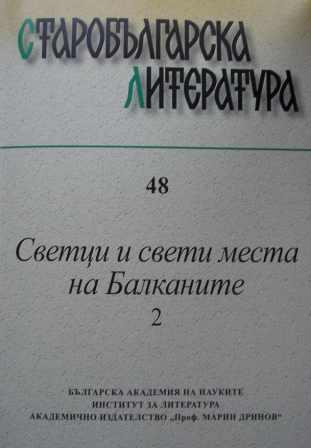Св. Теодор Тирон и трансформациите на неговия култ
St. Theodore Tyron and Transformations of His Cult
Author(s): Iskra Hristova ShomovaSubject(s): Language studies
Published by: Институт за литература - БАН
Summary/Abstract: The article studies the representation of the cult of St. Theodore of Amasea (known better as St. Theodore Tyron) in Orthodox Christian calendars, narratives, offices, religious images and in the folk culture. The article provides an overview of the Greek texts (vitae, sermons, offices), dedicated to St. Theodore, written in the period from the fifth to the tenth centuries, and of their Slavic translations, kept in manuscripts from the twelfth to the fifteenth centuries. The veneration of St. Theodore Tyron started as a typical cult of a martyr, who was persecuted in the early period of the Christianity. However, when St. Theodore miraculously appeared in the dream of the archbishop Eudoxios warning him and the citizens of Constantinople not to eat the food contaminated with sacrificial blood on the order of Julian the Apostate, the saint obtained a special place of celebration in the Christian calendar on the first Saturday of the Great Lent. His cult began to acquire new dimensions; he was revered as a glorious soldier, as well as a victorious dragon-slayer (draconomachos). His cult became even stronger and more popular when his twin saint appeared: St. Theodore Stratelates, who had similar characteristics and was celebrated in February on a date close to St. Theodore Tyron’s feast, as well as in June. The most conservative among the texts dedicated to St. Theodore Tyron are the hymnographic works, in which he is revered only as a martyr. Indeed, there is an exapostilarion, in which he is said to have destroyed a three-headed dragon, but most probably this is a rather common trope presenting the victory over paganism and might not be connected with his celebration as a dragon-slayer. In the narratives, new episodes were added, and on the frescoes, he was usually depicted together with his twin St. Theodore Stratelates as a pair of saints-soldiers rider, who changes the winter into spring and unlocks the spring waters. His feast was accompanied by a system of prohibitions, but in the most modern time the old customs are more and more forgotten and the horse races take central place in the feast. The twin character of the cult is demonstrated further in the existing of the feasts of St. Theodore of Winter on the Orthodox Saturday and St. Theodore of Summer on the 8th of June (the feast of St. Theodore Stratelates).
Journal: Старобългарска литература
- Issue Year: 2013
- Issue No: 48
- Page Range: 9-27
- Page Count: 19
- Language: Bulgarian
- Content File-PDF

